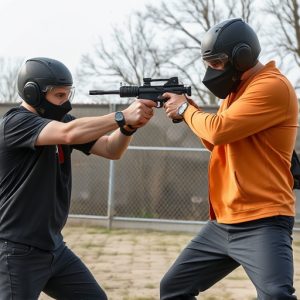Projectile vs Contact Stun Weapons: Best Choices for College Students’ Self-Defense
Self-defense stun guns tailored for college students come in two main types: projectile (pepper spra…….
Self-defense stun guns tailored for college students come in two main types: projectile (pepper spray, stun arrows) and contact weapons (tasers, stun bats). Projectiles are discreet and effective in crowded areas, while contact devices deliver electric shocks for immediate immobilization. Popular choices due to their ease of use, compact size, and high power outputs, these guns offer reliable protection, especially in unfamiliar or poorly lit campus zones. However, navigating legal complexities regarding school policies and local laws is crucial before acquiring one. Key factors when selecting a stun gun include range, power, simplicity of use, durability, and water resistance. Proper training through specialized courses ensures effective yet safe deployment, emphasizing calmness and adherence to legal guidelines for responsible self-defense.
“In today’s world, self-defense options are evolving, particularly on college campuses where safety is paramount. This article delves into the comparative analysis of two prominent self-defense tools: projectile and contact stun weapons. We explore their unique advantages, from the precision of projectile stun guns ideal for students facing potential threats on campus to the immediate impact of contact devices in real-self defense scenarios. Understanding these distinctions is crucial when choosing the right tool for personal safety.”
- Understanding Projectile and Contact Stun Weapons
- Advantages of Projectile Stun Guns for College Students
- Benefits of Contact Stun Devices in Self-Defense Scenarios
- Legal Considerations: College Campus Weapon Policies
- Factors to Consider When Choosing a Stun Device
- Safety and Training for Effective Self-Defense
Understanding Projectile and Contact Stun Weapons
Projectile and contact stun weapons are two distinct categories of self-defense tools, each with unique mechanisms and applications. Self-defense stun guns for college students often fall into one of these groups. Projectile stun weapons, such as pepper spray or stun arrows, operate by releasing a substance that causes temporary disorientation or pain when it makes contact with the target’s eyes, skin, or respiratory system. These tools are known for their non-lethal nature and are designed to provide a safe means of self-defense in crowded or fast-paced environments, like college campuses.
Contact stun weapons, on the other hand, deliver an electric shock directly to the target through physical contact. Stun bats, tasers, and certain stun guns fall under this category. The impact of these devices disrupts the nervous system, temporarily paralyzing the muscles and rendering the assailant immobile. Contact stun weapons are favored for their immediate effectiveness in close-quarters situations, making them viable options for personal safety while navigating college environments where potential threats may arise suddenly and unexpectedly.
Advantages of Projectile Stun Guns for College Students
College students looking for effective self-defense options often turn to stun weapons, and for good reason. Projectile stun guns, in particular, offer several advantages in this demographic. One of the key benefits is their ease of use; these devices typically fire non-lethal projectiles that stun the target without leaving permanent damage, providing users with a safe yet powerful defense mechanism. This is particularly appealing to students who might be concerned about unintended harm or legal repercussions associated with more aggressive self-defense tools.
Additionally, projectile stun guns are convenient and discreet. Their compact size makes them easy to carry on campus, ensuring that students can protect themselves in various situations without drawing unnecessary attention. This portability allows for peace of mind, knowing that a potential threat can be neutralized swiftly and quietly if needed. Moreover, many models offer high-power outputs, ensuring their effectiveness against would-be assailants, which is crucial for personal safety, especially in unfamiliar or poorly lit areas.
Benefits of Contact Stun Devices in Self-Defense Scenarios
In self-defense scenarios, especially for college students navigating potentially dangerous environments, contact stun devices offer several compelling benefits. Unlike projectiles that can miss or be evaded, stun guns require physical contact to deploy their effect, ensuring a more reliable response against assailants. This direct approach makes them particularly effective in close-quarters encounters where speed and certainty are paramount.
Additionally, self-defense stun guns for college students provide an advantage in terms of accessibility and ease of use. Their design allows users to activate them instinctively with a simple press or flip, eliminating the need for specialized training or complex techniques. This user-friendliness can be crucial in high-stress situations where every second counts, making contact stun devices a practical and empowering tool for personal safety.
Legal Considerations: College Campus Weapon Policies
On many college campuses across the US, there’s a growing trend among students to carry self-defense stun guns for protection. This shift is driven by concerns over personal safety, especially as campus violence and theft incidents rise. However, navigating legal considerations surrounding these weapons can be complex. College policies on weapon possession vary widely, with some schools allowing hidden stun guns while others strictly prohibit any kind of concealed weapon, even for self-defense purposes.
Students considering armed self-defense must also understand the potential legal ramifications if they use their stun gun in a manner other than as a last resort to protect themselves or others from imminent harm. Misuse or aggressive deployment could lead to serious charges and long-lasting consequences, not to mention the emotional and physical toll on all involved. It’s crucial that students thoroughly research their school’s weapon policies and local laws before considering carrying a stun gun for self-defense.
Factors to Consider When Choosing a Stun Device
When choosing a self-defense stun device, especially for college students, several key factors come into play. One of the primary considerations is the range and power of the stun gun. Self-defense stun guns for college students often need to cover longer distances than in other settings due to potential threats on campus. A higher voltage output generally translates to a greater stun range, ensuring you have time to escape if needed.
Another crucial aspect is the ease of use and reliability. College students may not always have the time or presence of mind to navigate complex devices during an emergency. Look for stun guns with simple activation mechanisms, such as a single press of a button. Additionally, water-resistant and durable designs can provide peace of mind, especially in unpredictable campus environments where your stun gun could face various challenges.
Safety and Training for Effective Self-Defense
For college students considering self-defense options, understanding the safety and training aspects of various weapons is paramount. Self-defense stun guns, also known as electric shock weapons, offer a non-lethal alternative to traditional firearms. These devices are designed to temporarily incapacitate an attacker, providing users with crucial time to escape potentially dangerous situations. However, their effectiveness hinges on proper usage and safety protocols.
Training is essential when it comes to self-defense stun guns. College students should seek out specialized courses or workshops that focus on not just how to operate the device but also scenario-based training. This includes learning safe handling practices, understanding the legal implications of using a stun gun in different jurisdictions, and practicing proper aim and deployment techniques. Such preparation ensures that students can respond calmly and effectively if confronted with a threatening situation, enhancing their personal safety while adhering to responsible use guidelines.
When it comes to self-defense, both projectile and contact stun weapons offer unique advantages. For college students, projectile stun guns provide a non-lethal option with a wide reach, enhancing safety on campus. Contact stun devices, however, are invaluable in direct confrontation scenarios, offering swift and effective protection. Understanding the legal landscape and choosing the right device is crucial for effective self-defense. With proper training, these tools can empower individuals to protect themselves, underscoring the importance of both technology and education in modern self-defense strategies.


